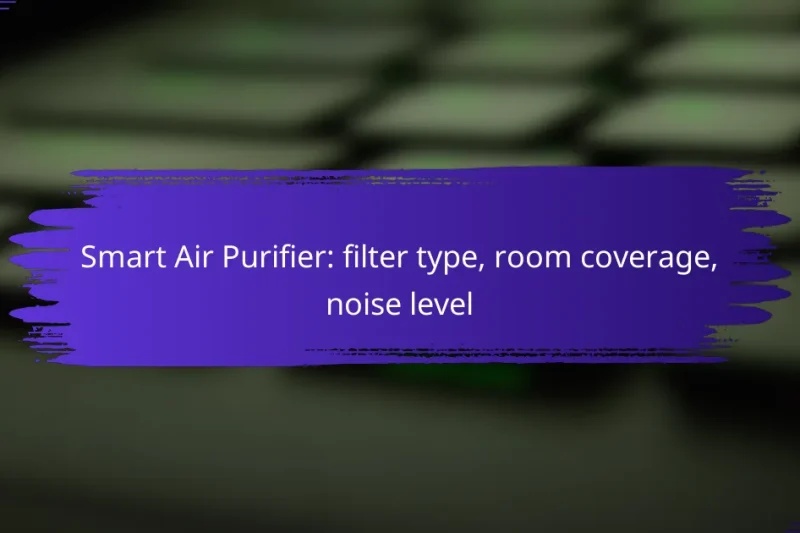Smart home hubs serve as the central command for managing a variety of devices, significantly enhancing … Smart Home Hub: compatibility with devices, user experience, priceRead more
Choosing the Right Smart Home Devices
Choosing the right smart home devices can significantly enhance your living experience by improving convenience, security, and energy efficiency. It’s essential to consider factors such as compatibility with existing systems, ease of use, and the ability to integrate with other devices to ensure a seamless smart home environment.
Smart Air Purifier: filter type, room coverage, noise level
Smart air purifiers are essential for maintaining clean air in large rooms, combining effective filtration, extensive … Smart Air Purifier: filter type, room coverage, noise levelRead more
Smart Light Bulbs: brightness, color range, connectivity
Smart light bulbs are designed to enhance your living space with adjustable brightness and a wide … Smart Light Bulbs: brightness, color range, connectivityRead more
What are the best smart home devices for Canadian homes?
The best smart home devices for Canadian homes include options that enhance convenience, security, and energy efficiency. Key considerations involve compatibility with local systems, ease of use, and the ability to integrate with other smart devices.
Philips Hue smart lighting
Philips Hue smart lighting provides customizable and energy-efficient lighting solutions for your home. These LED bulbs can be controlled remotely via a smartphone app, allowing you to adjust brightness and color to suit your mood or schedule.
Consider starting with a starter kit that includes a hub and a few bulbs. Philips Hue also works with voice assistants, making it easy to control your lighting hands-free. Ensure your Wi-Fi network is robust enough to support multiple devices for seamless operation.
Google Nest Hub
The Google Nest Hub is a versatile smart display that acts as a central control point for your smart home devices. It features a touchscreen interface that allows you to manage your lights, thermostat, and security cameras with simple voice commands or taps.
This device also offers helpful features like a digital photo frame and integration with Google services. When choosing a location for the Nest Hub, consider placing it in high-traffic areas like the kitchen or living room for maximum utility.
August Smart Lock
The August Smart Lock enhances home security by allowing you to control access to your home via your smartphone. You can lock or unlock your door remotely, grant access to guests, and monitor who enters your home.
Installation is straightforward, as it fits over your existing deadbolt. Ensure that your door frame is compatible and consider using the August Doorbell Cam for added security. This lock is particularly useful for renters, as it does not require changing the entire lock system.
Ecobee Smart Thermostat
The Ecobee Smart Thermostat helps optimize your home’s heating and cooling efficiency. It learns your schedule and preferences, adjusting the temperature accordingly to save energy and reduce utility bills.
With features like remote sensors and integration with voice assistants, you can control your home’s climate from anywhere. Look for models that qualify for local energy rebates to maximize your savings in Canada.
Amazon Echo Dot
The Amazon Echo Dot is a compact smart speaker that uses Alexa to control your smart home devices, play music, and provide information. Its small size makes it easy to place in any room, providing voice control capabilities throughout your home.
Consider using multiple Echo Dots to create a mesh network for better voice recognition across larger spaces. Be mindful of privacy settings, as the device is always listening for commands. Regularly review your device settings to ensure your data is secure.
How to choose smart home devices?
Choosing smart home devices requires careful consideration of compatibility, usability, energy efficiency, and security features. Prioritizing these factors will help ensure a seamless integration into your home environment.
Assess compatibility with existing systems
Before purchasing smart home devices, check their compatibility with your current systems, such as Wi-Fi networks, smart hubs, or voice assistants. Devices that work with popular platforms like Google Assistant or Amazon Alexa often provide better integration.
Look for devices that support common communication protocols like Zigbee or Z-Wave, as these can enhance interoperability among different brands. Always verify compatibility with your existing smart home ecosystem to avoid connectivity issues.
Consider user interface and ease of use
The user interface of smart home devices significantly impacts your experience. Opt for devices with intuitive apps or interfaces that simplify control and monitoring. A well-designed app can make managing multiple devices easier and more efficient.
Read user reviews to gauge the ease of use and setup process. Devices that require complicated installations or have steep learning curves may lead to frustration and decreased usage.
Evaluate energy efficiency
Energy-efficient smart home devices can help reduce utility bills and environmental impact. Look for devices with Energy Star ratings or similar certifications, which indicate compliance with energy efficiency standards.
Consider smart plugs or thermostats that allow you to monitor and control energy consumption. These devices can provide insights into your energy usage patterns, helping you make informed decisions about your energy consumption.
Check for security features
Security is crucial when selecting smart home devices, as vulnerabilities can expose your home network to risks. Ensure that devices have robust security features, such as encryption and regular firmware updates, to protect against potential threats.
Look for devices that offer two-factor authentication and strong password requirements. Regularly review security settings and stay informed about any vulnerabilities associated with your devices to maintain a secure smart home environment.
What are the top features to look for?
When choosing smart home devices, prioritize features that enhance usability and compatibility. Key aspects include voice control, integration with existing smart assistants, remote access capabilities, and customizable settings.
Voice control capabilities
Voice control allows users to operate devices hands-free, enhancing convenience and accessibility. Look for devices that support popular voice assistants like Amazon Alexa, Google Assistant, or Apple Siri.
Consider the responsiveness of voice commands; devices that recognize natural language and can process commands quickly (within low tens of milliseconds) are preferable. Ensure the device can understand different accents and languages if needed.
Integration with smart assistants
Devices that seamlessly integrate with smart assistants provide a more cohesive smart home experience. Check for compatibility with platforms such as Google Home or Amazon Echo, which can centralize control of multiple devices.
Review the ecosystem of your existing devices to avoid compatibility issues. A device that works well within your current setup can save time and reduce frustration.
Remote access and control
Remote access allows you to monitor and control devices from anywhere using a smartphone app. This feature is essential for security devices like cameras or alarms, enabling real-time alerts and adjustments.
Look for devices that offer a user-friendly app interface and reliable connectivity. Ensure that the device supports secure connections to protect your data and privacy.
Customizable settings
Customizable settings enable you to tailor device functionalities to your preferences. This can include scheduling, automation routines, and personalized notifications.
Choose devices that offer intuitive customization options, allowing you to easily set up routines based on your daily schedule. Avoid devices with overly complex settings that may lead to confusion or underutilization.
What are the costs of smart home devices in Canada?
The costs of smart home devices in Canada can vary significantly based on the type and brand. Generally, you can expect to spend anywhere from a few hundred to several thousand Canadian dollars depending on the devices you choose and their functionalities.
Average price range for smart speakers
Smart speakers in Canada typically range from around CAD 50 to CAD 300. Entry-level models, like the Amazon Echo Dot or Google Nest Mini, are more affordable, while premium options like the Apple HomePod can be on the higher end.
When selecting a smart speaker, consider the features you need, such as sound quality, voice assistant compatibility, and additional functionalities like smart home integration.
Costs for smart lighting solutions
The price for smart lighting solutions can vary widely, starting from about CAD 15 for individual smart bulbs to over CAD 200 for complete starter kits. Brands like Philips Hue and LIFX offer a range of products catering to different budgets.
Keep in mind that while smart bulbs may have a higher upfront cost, they can lead to savings on energy bills over time through energy-efficient technology.
Installation costs for smart locks
Installing smart locks in Canada can cost between CAD 100 and CAD 300, depending on the complexity of the lock and whether professional installation is required. Some smart locks are designed for easy DIY installation, which can save you money.
Before purchasing, check if the smart lock is compatible with your existing door hardware and consider any additional costs for tools or accessories needed for installation.
Monthly fees for subscription-based services
Many smart home devices come with optional subscription services that can range from CAD 5 to CAD 30 per month. These services often provide additional features such as cloud storage for security camera footage or advanced automation options.
Evaluate whether the benefits of these subscriptions align with your needs, as some devices can function effectively without ongoing fees. Always check for free trials to test the service before committing.
What are the benefits of smart home devices?
Smart home devices offer numerous advantages, including improved convenience, energy savings, and enhanced security. By automating tasks and providing remote control, these devices can significantly enhance your daily living experience.
Increased energy efficiency
Smart home devices can help reduce energy consumption by optimizing usage patterns. For example, smart thermostats learn your schedule and adjust heating or cooling accordingly, potentially saving 10-15% on energy bills. Smart lighting systems can automatically turn off when rooms are unoccupied, further contributing to energy savings.
When choosing energy-efficient devices, look for those with Energy Star ratings or similar certifications. These devices often provide real-time energy usage data, allowing you to monitor and adjust consumption effectively.
Enhanced home security
Smart home devices significantly bolster home security through features like remote monitoring and alerts. Smart cameras and doorbells enable you to view live feeds and receive notifications on your smartphone, ensuring you stay informed about any unusual activity around your property.
To maximize security, consider integrating various devices such as smart locks, motion sensors, and alarm systems. This interconnected approach allows for a comprehensive security solution, providing peace of mind whether you are home or away.


